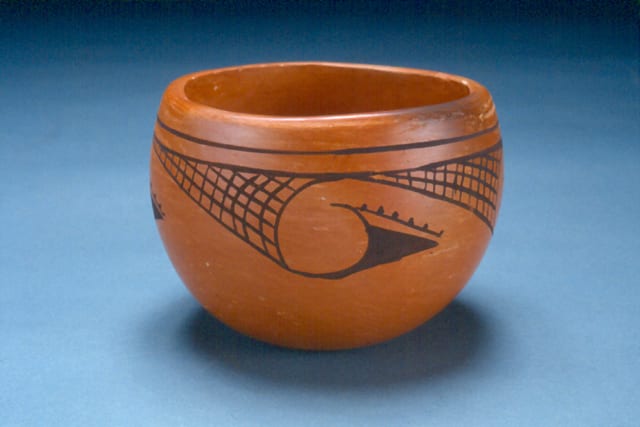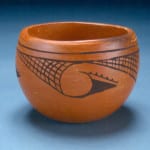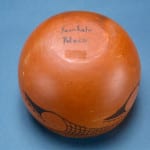Hopi red-ware pot, old Polacca-ware scroll design by Fern Lalo, Polacca. Although new, the painting on this pot incorporates Zuni “rain bird” design elements that were characteristic of “Polacca C” ware before the Sikyatki revival inspired by Keam and Nampeyo in the 1880s. Called a “rain bird” design by Ruth Bunzel, the design represents a “crook” the “… drumstick used by (Zuni) fraternities in their ceremonies. It is made of willow turned back on itself and tied… (it is) a prayer in rain.” (1972:94-95). For such a Polacca C rain-bird designed pot from the 1880s, see 1994-14. For other examples of Polacca Ware “C” rain bird designs, see Wade & McChesney (1981:594, and p. 356, Keam #863 and p. 365, Keam #888). See also, the circa 1880 Walpi Polychrome pictured in Dittert (1980:36, Fig. 21). The same Zuni rainbird spirit is reflected in the design of KM #119 in Wade & McChesney (1980:72). Very similar arabesque designs on stew bowls made by Poolie at Sichomovi and Mrs. Keely at Tewa (Hano) during the 1930s are described in Allen (1984:87 and 99). [For a bowl by Poolie, see 2009-11.] In 1959, some Zuni-inspired Hopi pots were still being made for sale at the annual Hopi Show in Flagstaff (Sikorski, 1968:44-47). However, pot 1992-04 is the first new example of this Polacca-ware/Zuni style that I have seen. Lydia Wyckoff (1985) indicates that a similar traditional design is maintained by a few women on Third Mesa, but I was unable to find any evidence of this on 1991 or 1992 trips.
For an old Polacca C pot in the collection of similar design, see 1994-14. For more pots in the collection with the “Rain Bird Design,” see the Category List.



